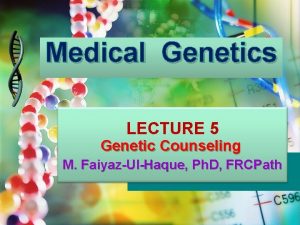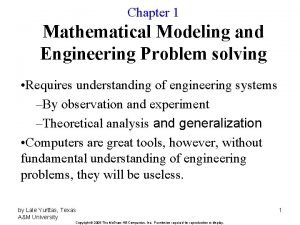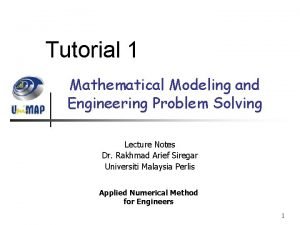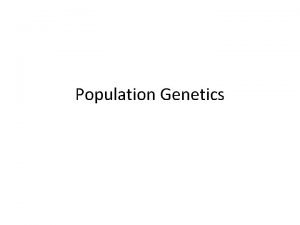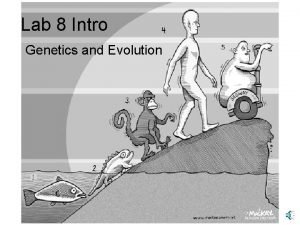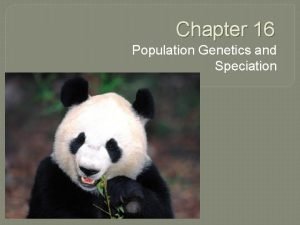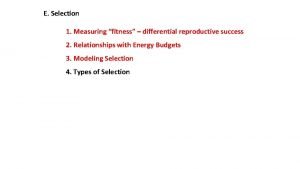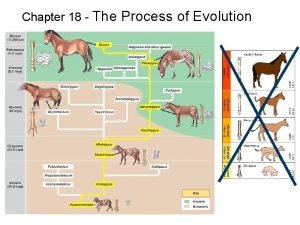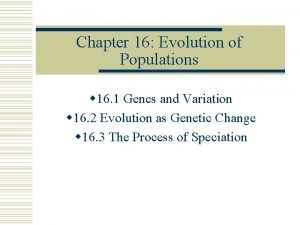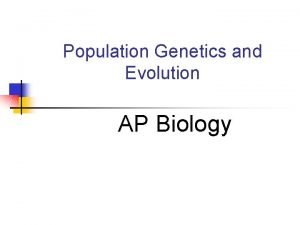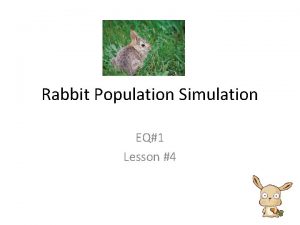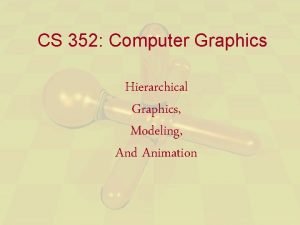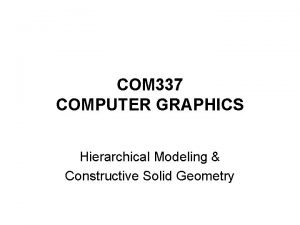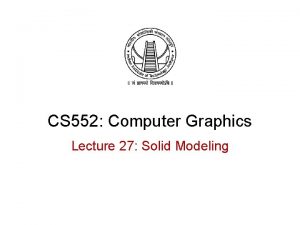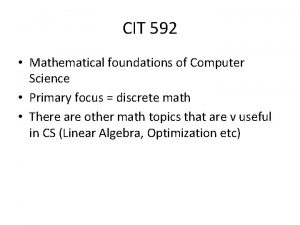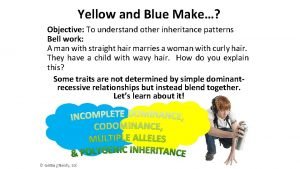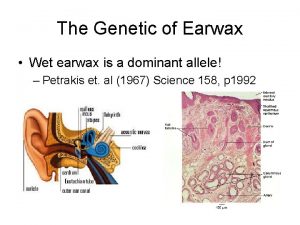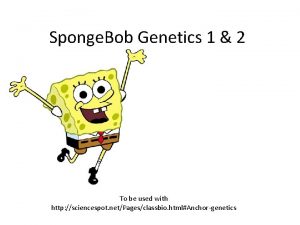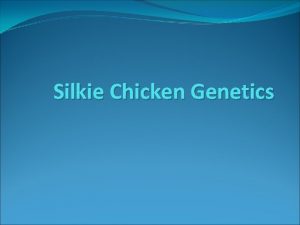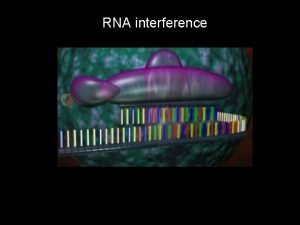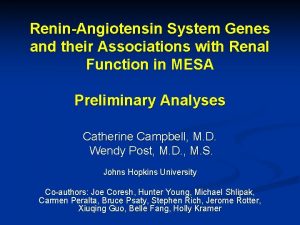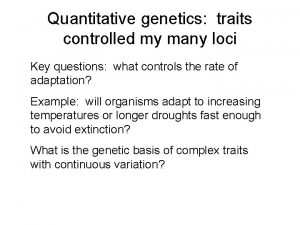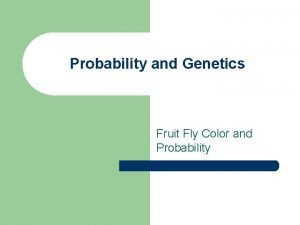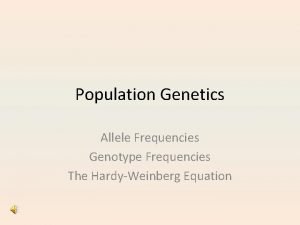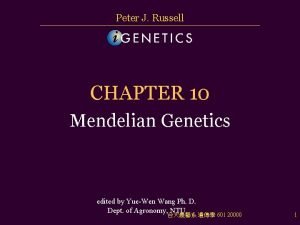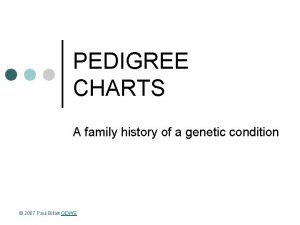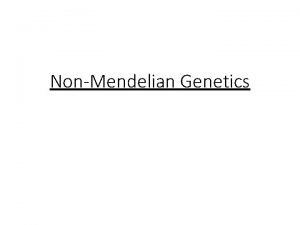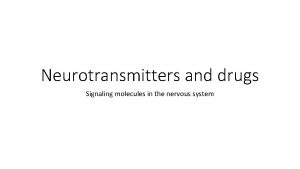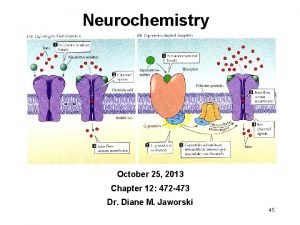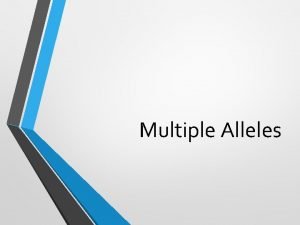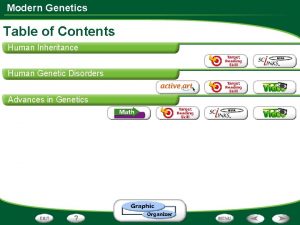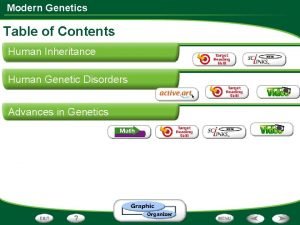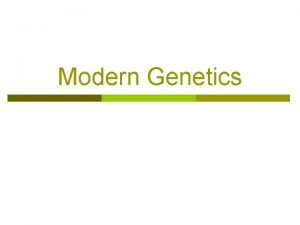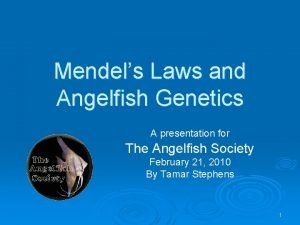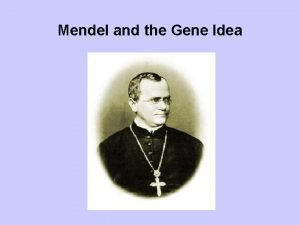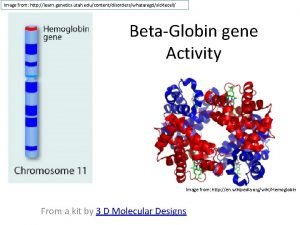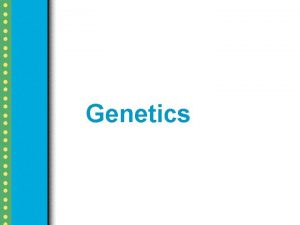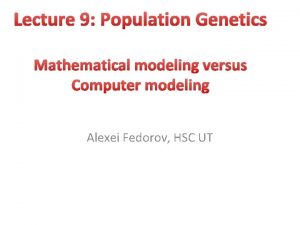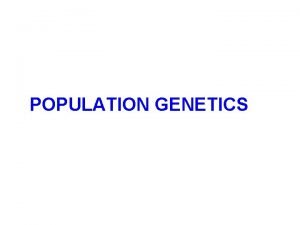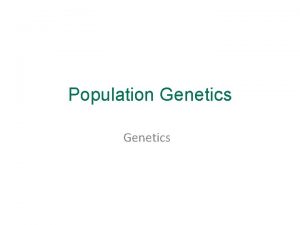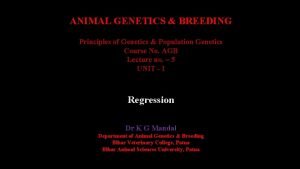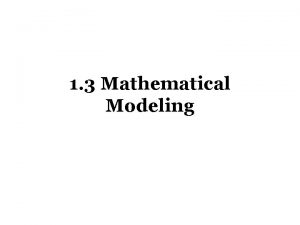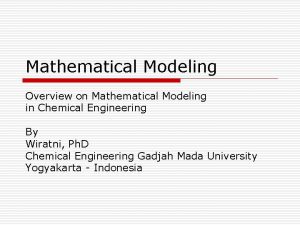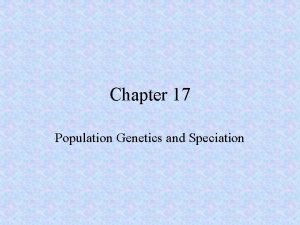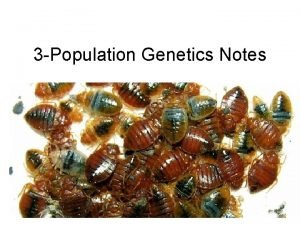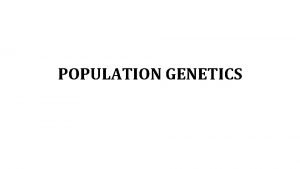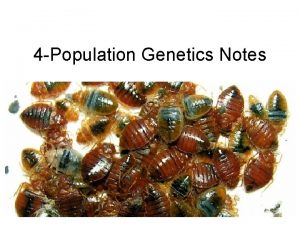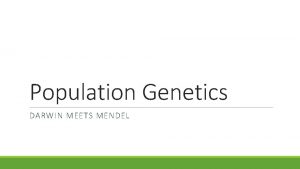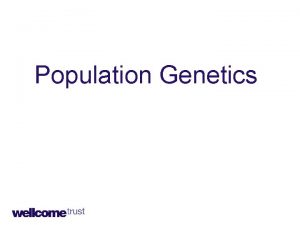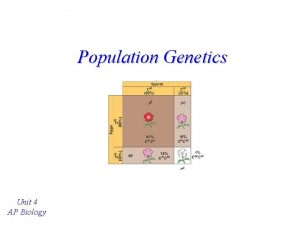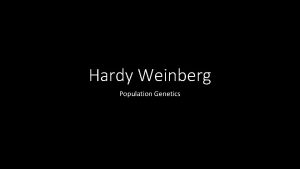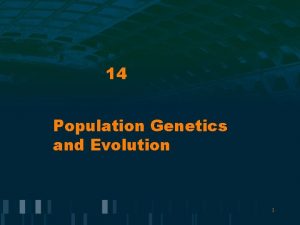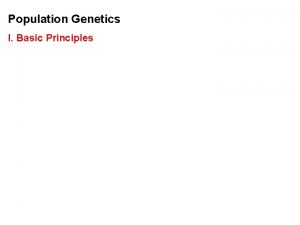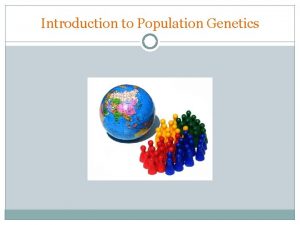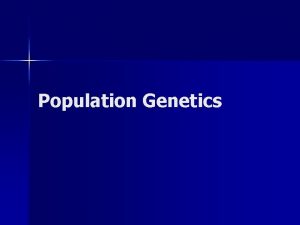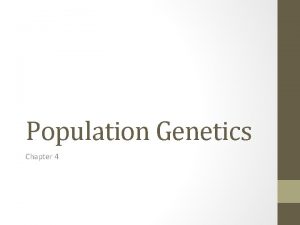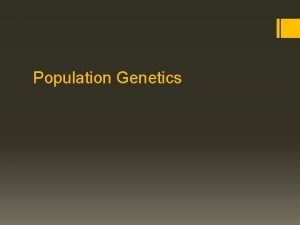Lecture 8 Population Genetics Mathematical modeling versus Computer

























































- Slides: 57

Lecture 8. Population Genetics Mathematical modeling versus Computer modeling February 06 th, 2012 Alexei Fedorov, HSC UT

Every human being has about 80 de novo mutations • It means that two persons from an isolated village have thousands of nucleotide differences in their genomes. • Many of these mutations will be drifted away, some of them will be fixed in the population, while the rest will be present as polymorphic biomarkers for a considerable period of time. • A special field of science that tries to predict the fate of these mutations is known as Population Genetics

Wikipedia Population genetics is the study of allele frequency distribution and change under the influence of the four main evolutionary processes: natural selection, genetic drift, mutation and gene flow. It also takes into account the factors of recombination, population subdivision and population structure. It attempts to explain such phenomena as adaptation and speciation.

Known controversies in Population Genetics: Selectionism versus Neutralism • “The Neutral Theory of Molecular Evolution in the Genomic Era” 2010, by Masatoshi Nei, Yoshiyuki Suzuki, and Masafumi Nozawa. • “Neutralism and selectionism: a networkbased reconciliation” 2008 by Andreas Wagner

Homework assignment • Read two reviews by Nei et al. 2010 and Wagner 2008. • List all arguments presented in these papers that support Neutralism. • List all arguments presented in these papers that support Selectionism.

From Andreas Wagner paper 2008 “The tension between neutralism and selectionism is at least as old as the field of molecular evolution 1”. “…To neutralism, beneficial mutations are rare and are fixed less frequently than neutral or slightly deleterious mutations 2. By contrast, according to selectionism, beneficial mutations are abundant: most mutations that go to fixation in a population would be beneficial, or are at least linked to abundantly occurring beneficial mutations. ”

Each mutation can be characterized by selection coefficient (s) and fitness (W) From Nei et al. 2010

Selection coefficient (S) and fitness (w) (Wikipedia) Natural selection is the fact that some traits make it more likely for an organism to survive and reproduce. Population genetics describes natural selection by defining fitness as a propensity or probability of survival and reproduction in a particular environment. The fitness is normally given by the symbol w=1+s where s is the selection coefficient. Natural selection acts on phenotypes, or the observable characteristics of organisms, but the genetically heritable basis of any phenotype which gives a reproductive advantage will become more common in a population (see allele frequency). In this way, natural selection converts differences in fitness into changes in allele frequency in a population over successive generations.

PROBLEM !!! It is absolutely impossible to measure the selection coefficient S for a given mutation in experiments with complex organisms like mouse or wheat … unless this mutation is deleterious Therefore, the crucial parameter (S) for each theory is totally elusive and the dispute between Selectionism versus Neutralism cannot be resolved!

How has the highest fitness Arnold Schwarznegger, Andrea Boceli, Stephen Hawking, A marathon runner, Usain Bolt, Warren Buffet, Lindsay Lohan ?

Fitness – a tricky illusive parameter • Multiple environmental habitats (goose) • Environmental changes (temperature, water conditions, chemistry (volcano), etc. ) • A mutation could be good for one environment and very bad for others (globin gene example). CONCLUSION: Assignment of scalar values for S and W is an enormous simplification. These parameters should be matrixes that change in time.

Problems with bacteria • In a haploid organism fitness parameter (w) expresses a growth rate of that haploid genotype (p. 206, Hartl and Clark, 4 th edition Principles of Population Genetics) • However, a vast majority of bacteria (~99%) in our planet is impossible to growth in the lab (So, is their fitness equal to zero? )

A vast majority of equations in Population Genetics study a single locus (enormous simplification) From Sanford’s “Genomic Entropy” (p. 69): “…Traditionally, geneticists have studied the problem of mutations by simply considering one mutation at a time. It has been widely assumed that works for one mutation can be extended to apply to all mutations. … This is like saying that if I can juggle three balls I can juggle 300! We are learning that the really tough problems are not seen with single genes but arise when we consider all genetic units combined (the whole genome)”

Each mutation can be characterized by selection coefficient (s) and fitness (W) From Nei et al. 2010

Biological traits result in part from interactions between different genetic loci. This can lead to sign epistasis, in which a beneficial adaptation involves a combination of individually deleterious or neutral mutations; in this case, a population must cross a "fitness valley" to adapt. Recombination can assist this process by combining mutations from different individuals or retard it by breaking up the adaptive combination. Here, we analyze the simplest fitness valley, in which an adaptation requires one mutation at each of two loci to provide a fitness benefit. We present a theoretical analysis of the effect of recombination on the valley-crossing process across the full spectrum of possible parameter regimes. We find that low recombination rates can speed up valley crossing relative to the asexual case, while higher recombination rates slow down valley crossing, with the transition between the two regimes occurring when the recombination rate between the loci is approximately equal to the selective advantage provided by the adaptation. In large populations, if the recombination rate is high and selection against single mutants is substantial, the time to cross the valley grows exponentially with population size, effectively meaning that the population cannot acquire the adaptation. Recombination at the optimal (low) rate can reduce the valley-crossing time by up to several orders of magnitude relative to that in an asexual population.

Elegant and straightforward solution by Weissman et al. 2010

From Dr. Sanford’s book (p. 53) … The models did not match biological reality, but these men [famous scientists] had an incredible aura of intellectual authority, their arguments were very abstract, and they used highly mathematical formulations which could effectively intimidate most biologists.

Genetic Entropy & the Mystery of the Genome (2005) The book claims that the genome is deteriorating and therefore could not have evolved in the way specified by the Modern evolutionary synthesis. Sanford is a prolific inventor with more than 30 patents. At Cornell Sanford and colleagues developed the "Biolistic Particle Delivery System" or so-called "gene gun”. He is the co-inventor of the Pathogenderived Resistance process and the co-inventor of the genetic vaccination process. He was given the "Distinguished Inventor Award" by the Central New York Patent Law Association in 1990 and 1995. He has founded two biotechnology companies, Sanford Scientific and Biolistics. In 1998 he retired on the proceeds from the sale of his biotech companies, and continued at Cornell as a courtesy associate professor. http: //www. youtube. com/watch? v=0 -rx_l. S 3 Zw. I

From Dr. Sanford’s presentation http: //www. youtube. com/watch? v=0 -rx_l. S 3 Zw. I

CONCLUSION: Human genome is enormously complicated system and we still at the very beginning of understanding its structure, functioning, and evolution. HOMEWORK ASSIGNMENT #2 Watch my public lecture from the Internet about an alternative to Dr. Sanford explanation for the origin of new genes http: //bpg. utoledo. edu/~afedorov/lab/ Write a half-page summary.

Mathematical modeling versus Computer modeling in Population Genetics • Mathematical approach requires non-trivial equations and deep knowledge of math. • Computer Modeling = A New Kind of Science “ ≈ Computer experiments are able to reveal unexpected results and open a whole new way of looking at the operation of our universe”

Advantages of computer modeling • No mathematics • Allows to observe behavior of complex systems with hundreds of variables and parameters (e. g. thousands of genes with thousands of mutations in organisms exposed to multiple environments) • Allows to study influences of specific non-random arrangement of system elements (gene deserts, hot spots of recombinations, etc) • Allows to make a vast number of changes in the system and investigate their effects (e. g. populations with constant families, free mating, complex families, any relations between fitness and number of offspring, etc. )

Matrix Algorithms for Genome Evolution ? A computational approach for modeling intricacies of the human genome evolution Alexei Fedorov, Associate Professor, Department of Medicine University of Toledo, HSC

“ 1000 Genomes” international project

THE 1000 GENOME PROJECT q ASW African Americans q YRI Nigeria q LWK Kenya q q q CEU TSI FIN GBR IBS Europeans in America Italy Finland Great Britain Spain q CHB Chinese in Beijing q CHS Chinese from South q JPT Japan q CLM Colombians q MXL Mexicans q PUR Puerto Rican CHB LWK FIN CHS JPT YRI GBR 1000 Genome Project ASW TSI CEU PUR CLM IBS MXL

Number Of Pairs of Individuals distribution of the number of genetic variants among pairs of individuals from the same 1000 5 European population 900 3 Asian Populations 800 Populations 3 African Population s 700 600 500 400 3 American Populations 200 100 0 2. 7 2. 9 3. 1 3. 3 3. 5 3. 7 3. 9 4. 1 4. 3 4. 5 4. 7 4. 9 5. 1 5. 3 Number of Differences * 1, 000 BOTTOM LINE: Two individuals, even from the same population, differ from one another by millions of SNPs 5. 5

Major haplotypes of human hemeoxygenase-1 gene (only of frequent SNPs are shown) The bottom line: Mutations never exist alone but in groups linked with each other and forming haplotypes that slowly change due to meiotic recombination and selection/drift

Every human being has 50 - 100 de novo mutations Many of these mutations will drift away. Some of them will be eventually fixed in the population. The rest will be present as polymorphic biomarkers for a considerable period of time. The major question I would like to answer at this presentation: What parameters are most important for maintaining the fitness of population under the intense influx of novel mutations when deleterious ones overwhelm beneficial?

Mathematical modeling versus Computer modeling in Population Genetics • Not trivial • Considerable simplificaton of reality • Several opposing theories FROM: Weissman et al. 2010 The rate of fitness-valley crossing in sexual populatio

Mathematical modeling versus Computer modeling in Population Genetics Cellular Automata Game of life Computer experiments are able to reveal unexpected results and open a whole new way of looking at the operation of our universe BOTTOM LINE: Instead of utilizing mathematical modeling, prediction of the fate of mutations can be approached more fruitfully from a different dimension: taking advantage of the enormous power of contemporary supercomputers.

Advantages of computer modeling • No mathematics • Allows observation of cooperation of thousands elements (SNPs) • Behavior of the system with multiple parameters and inhomogeneity

Matrix Algorithms for Genome Evolution (MAGE) Advanced version MAGE. java 150 pages of script Core version MAGE. pl 15 pages

Genetically Identical Starting Population, size N Mutations in each individual Mating between N/2 mating pairs Combine male and female gametes to make offspring Calculate fitness of offspring N most fit offspring to survive and reproduce Observe population fitness & DNA sequences changes after a certain number of generations

A large portion of a real genomic sequence (even whole chromosomes of human or other species) can be assigned as a reference genome for a model population • A user specifies the number of individuals in the population (parameter N) • Each individual is constructed as a diploid genome that descended as two haploid gamete genomes from its parents.

Mutations are created randomly taking a user-defined parameter μ (number of novel mutations per gamete) • Each individual accumulates a number of mutations in their germ cells – Effects fitness of next generation inheriting the mutations • Effect of mutation on fitness of offspring: “selective advantage” value (s) • Beneficial: improves fitness • Deleterious: decreases fitness

Upon generation of a mutation, MAGE assigns a selection coefficient (s) to the mutation using a userdefined s-distribution. Exponential Decay Distribution Normal Distribution 2. 5 Frequency 2 1. 5 1 0. 5 0 -4 -2 S-Value 0 2 -5 1. 4 1. 2 1 0. 8 0. 6 0. 4 0. 2 0 0 S-Value 5 • Since s is an experimentally immeasurable parameter, MAGE assigns nonnormalized values of s for generated mutations. • When s > 0 the mutation is beneficial • When s< 0, the mutation is deleterious BOTTOM LINE: Absolute values of s are not of primary importance, yet the distribution of these s-values among all mutations is crucial. Distribution of s is a D-parameter

Our popular distributions (D parameters) Deleterious mutations are 9 times more abundant than beneficial

Scheme of meiotic recombination Number of recombination events per gamete – parameter r Maternal Paternal 5’ 3’ 3’ 5’ r=1 Gamete 1 5’ 3’ Gamete 2 5’ R=15 3’

Mating schemes and generation of offspring Number of offspring per individual parameter α α=3 α=6

Calculation of fitness for each generated offspring Maternal allele: fitness Wm Paternal allele: fitness Wp • MAGE calculates fitness for each gene for both parental chromosomes by summing all the s-values of mutations within that gene. • The fitness of the maternal allele for the given gene (wm) will be a sum of s-values for all SNPs within maternal haplotype of this gene, while the fitness of the paternal allele (wp) will be a sum of s-values for all the paternal SNPs.

The fitness of a gene in is calculated from the wm and wp values and also another user-defined parameter, the dominance coefficient (h parameter). • In a co-dominance mode (h=0. 5), the gene fitness is the average of the fitness of maternal and paternal alleles. • Under a recessive mode (h=1), which corresponds to recessive genes, the fitness is the maximum between wm and wp values (heterozygotes with one deleterious allele are healthy). • for a dominant mode (h=0), which corresponds to dominant genes, the gene fitness is the minimum between wm and wp values. For a general case, the gene fitness is calculated by the formula: w = min(wm, wp) + h abs(wm-wp) × Fitness of an individual is the sum of fitnesses of all his/her genes

Fitness Darwinian selection – The fittest are survive only N fittest offspring will survive and create new generations.

Results of MAGE simulations • • • Population size N from 50 to 200 Mutations per gamete μ from 1 to 50 Recombinations per gamete r from 0 to 48 Dominance coefficient h 0, 0. 5, or 1 Distribution of selection coefficients D: (deleterious mutations 8 -10 overwhelm beneficial ones) • Offspring per individual α from 2 to 10 Does NOT matter Number of genes in the genome 600 -600 Length of genes 1000 bp -10, 000 bp

MAGE modeling number of SNPs in population

MAGE modeling number of SNPs in population

Change of population fitness in generations when deleterious mutations overwhelm beneficial ones

Change of population fitness in generations when deleterious mutations overwhelm beneficial ones

Major Conclusion • Computer modeling with MAGE has demonstrated that the number of meiotic recombination events per gamete is among the most crucial factors influencing population fitness. • In humans, these recombinations create a gamete genome consisting on an average of 48 pieces of corresponding parental chromosomes. Such highly mosaic gamete structure allows preserving fitness of population under the intense influx of novel mutations even when the number of mutations with deleterious effects is up to ten times more abundant than those with beneficial effects. Our formula for healthy population r ≥μ

How haplotypes look like in MAGE modeling?

Probability of fixation of a mutation with s = +1

MAGE outcome on the probability of fixation of a mutation with selection coefficient s • For a specific set of parameters, probability of fixation of neutral mutation significantly deviates from 1/2 N. For example, for (α =10, h=0, r=1, D=exp. C, µ=1, N=50) it is 2. 1 times higher. • A common view that the probability of ultimate fixation of a beneficial mutation (π) should be proportional to s (π ≅ 2 s) and not depend on the population size (Patwa and Wahl 2008). Our MAGE results demonstrate that the probability of fixation of a beneficial mutation π also depends on the combination of the six aforementioned parameters (N, μ, r, h, α, D). This phenomenon can be explained by the linkage of deleterious, beneficial, and neutral mutations within haplotypes and selecting them as whole units.

Mating Schemes with random pairs Scheme 2: Promiscuity Scheme 1: True family values Random assigned male and female repeat Random match Each couple has the same number of offspring Constant mating pairs The random mating continues until equal number of offspring are born. Temporary mating pairs

Mating Schemes sorted by fitness Scheme 3: Best-to-Best fit Random assigned Best fit matches each other Each couple has the same number of offspring Scheme 4: Artificial scheme Best-to-Least fit Random assigned Best fit matches the least fit Each couple has the same number of offspring

Mating Schemes sorted by fitness & variable offspring numbers Scheme 6: Couple fitness -> Number of offspring Scheme 5: Male fitness -> Number of offspring Random assigned male and female Random assigned Best fit matches each other Random match The number of offspring is based on the male fitness The number of offspring is based on the couple fitness

Mating Schemes: Herd – Only the Best male is reproduced Scheme 7 Random assigned Only the best fit male is left Same number of the offspring

Average Fitness None Fitness Among Mating Schemes 1. 5 1 M 1 0. 5 0 M 2 0 0. 5 1 1. 5 2 2. 5 3 -0. 5 -1 3. 5 4 4. 5 5 Thousands M 3 M 4 -1. 5 M 5 -2 -2. 5 M 6 -3 M 7 -3. 5 -4 Generations

Homework assignment • Read two reviews by Nei et al. 2010 and Wagner 2008. • List all arguments presented in these papers that support Neutralism. • List all arguments presented in these papers that support Selectionism.
 Genetic counseling definition
Genetic counseling definition Helen erickson nursing theory
Helen erickson nursing theory Dimensional modeling vs relational modeling
Dimensional modeling vs relational modeling Modeling mechanical systems examples
Modeling mechanical systems examples Mathematical modeling and engineering problem solving
Mathematical modeling and engineering problem solving Mathematical modeling and engineering problem solving
Mathematical modeling and engineering problem solving Non mathematical economics
Non mathematical economics Genetics
Genetics Lab 8 population genetics and evolution
Lab 8 population genetics and evolution Population genetics and speciation worksheet answer key
Population genetics and speciation worksheet answer key Population genetics
Population genetics The far side comics
The far side comics Population genetics
Population genetics Population genetics definition
Population genetics definition Modeling population growth rabbits answer key
Modeling population growth rabbits answer key 01:640:244 lecture notes - lecture 15: plat, idah, farad
01:640:244 lecture notes - lecture 15: plat, idah, farad Chapter 4 section 1 population dynamics answer key
Chapter 4 section 1 population dynamics answer key Population ecology section 1 population dynamics
Population ecology section 1 population dynamics Population ecology section 1 population dynamics
Population ecology section 1 population dynamics Chapter 4 section 1 population dynamics study guide answers
Chapter 4 section 1 population dynamics study guide answers Computer graphics
Computer graphics Hierarchical modeling in computer graphics
Hierarchical modeling in computer graphics Solid
Solid Mathematical foundations of computer graphics and vision
Mathematical foundations of computer graphics and vision Cit 592 mathematical foundations of computer science
Cit 592 mathematical foundations of computer science Computer security 161 cryptocurrency lecture
Computer security 161 cryptocurrency lecture Computer-aided drug design lecture notes
Computer-aided drug design lecture notes Computer architecture lecture notes
Computer architecture lecture notes Isa vs microarchitecture
Isa vs microarchitecture What does yellow and blue make
What does yellow and blue make Earwax type genetics
Earwax type genetics Sponge billy bob
Sponge billy bob Silkie colors
Silkie colors Sexual reproduction and genetics section 1 meiosis
Sexual reproduction and genetics section 1 meiosis Forward genetics
Forward genetics Genetics model
Genetics model Quantitative genetics
Quantitative genetics Probability in genetics
Probability in genetics Learn.genetics.utah/content/addiction/mouse
Learn.genetics.utah/content/addiction/mouse Allelic and genotypic frequencies
Allelic and genotypic frequencies Trihybrid cross
Trihybrid cross Eye color genetics chart with grandparents
Eye color genetics chart with grandparents Multiple alleles
Multiple alleles Http://learn.genetics.utah.edu/content/addiction/
Http://learn.genetics.utah.edu/content/addiction/ Epinephrine in the brain
Epinephrine in the brain Multiple allele
Multiple allele Human inheritance modern genetics answer key
Human inheritance modern genetics answer key Modern genetics human inheritance answer key
Modern genetics human inheritance answer key Modern genetics human inheritance answer key
Modern genetics human inheritance answer key Angelfish genetics
Angelfish genetics Father of genetics
Father of genetics Pedigree miscarriage symbol
Pedigree miscarriage symbol Multiplication and addition rule genetics
Multiplication and addition rule genetics Section 11-3 exploring mendelian genetics answer key
Section 11-3 exploring mendelian genetics answer key Learn genetics utah edu
Learn genetics utah edu Section 14-3 human molecular genetics answers
Section 14-3 human molecular genetics answers Introduction to genetic analysis tenth edition
Introduction to genetic analysis tenth edition What does the notation tt mean to geneticists?
What does the notation tt mean to geneticists?
